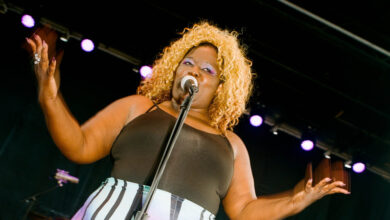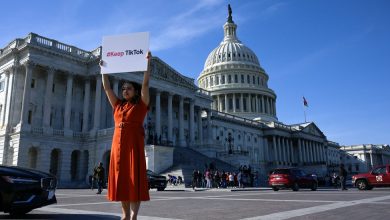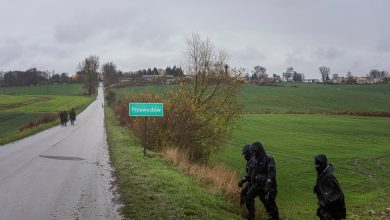‘Swimming Wasn’t for Us’

YEADON, Pa. — On a hot summer afternoon in 1959, hundreds of Black families in this little town just outside Philadelphia gathered on Union Avenue to cool off and make some history.
Only two years had passed since three of the families had been refused membership by the whites-only swim club in town, a rejection that set off a bustle of kitchen table meetings and door-to-door fund-raising. Now on this mid-July afternoon, the Nile Swim Club was celebrating its grand opening: the first Black-owned private swim club in the country.
After the speeches, the board members waded into the new pool, and after what Bill Mellix, who was 13 at the time, remembers as an interminable few minutes of waiting, the children were invited to join them. They laughed, splashed and reveled in their achievement. But there was one thing that most of them did not do.
“None us knew how to swim,” Mr. Mellix said.

André Kenneth Andrews helping Liam Anderson, 12, float on his back. Credit…Rachel Wisniewski for The New York Times
The mere existence of the Nile Swim Club was a strike against the bigoted history of recreational swimming in the United States. But there are legacies of that history that run deeper than racist membership policies — legacies that the Nile is now trying to remedy one swimmer at a time.
To this day, Black children are far more likely than white children to report low or no swimming ability, a disparity that underlies other, grimmer statistics. Black people drown at a rate 50 percent higher than that of white people, according to the Centers for Disease Control and Prevention. In swimming pools in particular, the drowning rate for Black children ages 10-14 is nearly eight times that of white children of the same age. The disparities are only reinforced by their tragic consequences.
“My mother’s sister drowned when she was 17,” said Victoria Pearsall, sitting in the poolside shade at the Nile, recalling how the shock of her aunt’s death reverberated across generations in her family. “That made a cycle of kids not knowing how to swim.”
Around a long-abandoned underground swimming pool at Philadelphia’s Fairmount Water Works, an exhibition called “Pool: A Social History of Segregation,” explains how vicious cycles like this began.
From the country’s earliest days, swimming was an activity curbed and constrained by racism, brutally punished by slave owners who saw it as an avenue to freedom. But in the late nineteenth century, some big Northern cities, with Philadelphia leading the way, began building city pools in a burst of Victorian civic-mindedness, viewing them as public baths for the working class.
These pools “reinforced class and gender divisions but not racial distinctions,” wrote Jeff Wiltse in his book “Contested Waters: A Social History of Swimming Pools in America.” Poor and working-class boys, Black and white, crowded into city pools on hot summer days, while women and members of the middle-class swam at different times or in different pools, if at all.
This changed by the 1920s, as an appetite for exercise facilities had taken hold among the well-off. Women and men started swimming together, and bathing suits alluringly shrank. In direct reaction to the mixing of genders, racial segregation became the rule, enforced, if not by law then by violence.
From this point, the history of swimming pools unfolds like so many other social spaces in America. As Black people began challenging pool segregation and winning in court, white people began deserting public pools altogether. Cities closed pools rather than accept integration, and private pools boomed in white backyards across the country.
Urban swimming opportunities have waxed and waned ever since, at the mercy of funding and municipal attention. Over the past couple of years, a nationwide lifeguard shortage has forced many urban pools to close or to open without adequate staffing, including more than a dozen that were shut down in Philadelphia this summer.
For many Black people growing up in past decades in Philadelphia, even though it boasts the highest number of swimming pools per capita of any major city, learning how to swim was almost a matter of luck: whether you lived near a city pool, whether there were instructors there, whether your family encouraged it.
“If you didn’t have the stuff to go to swimming in, like swimsuits and trunks and things like that, you weren’t allowed in,” said Lynn Ruff, 58, who was one of the few in her circle of friends who learned to swim as a child. A lot of people she knew just figured “swimming wasn’t for us.”
Ms. Ruff is now a lifeguard and instructor herself, taking on the job after being laid off from a bank in her mid-40s. A grandmother of five, she insists that everyone should — and anyone can — learn to swim. In the off-season, she teaches swimming at a school for the blind.
Among the adults sitting around the pool at the Nile Swim Club, it was not hard to find skepticism about the claim that anyone could learn. Ms. Pearsall, for her part, said she had no plans to start swimming at this point. But as she talked, she watched James, her 10-year-old son who was in the water, breaking the family cycle.
“Kick, kick, kick, kick, kick, kick!” shouted André Kenneth Andrews, a bald and goateed 69-year-old retiree who spends his mornings exhorting scores of girls and boys into becoming swimmers. “I’m not kidding, you kick them feet!”
In 2019, board members at the Nile Swim Club began talking about the racial disparities in swimming ability and what they could do about them. They saw the main obstacles as money, time and a feeling of comfort that was crucial before the anxiety of the lessons themselves.
“Most swim clubs you go into, you’re not going to see a pool full of Black kids,” said Lisa Ivery, a board member at the Nile. She grew up in Yeadon in the 1980s and remembered even her close white friends talking of pool parties at local clubs to which she was conspicuously not invited. (The whites-only swim club in Yeadon, which prompted the creation of Nile in the first place, went out of business a couple of decades ago.)
The board came up with a program called “No Child Will Drown in Our Town,” offering 10 days of free swimming lessons to anyone who signs up. Anthony Patterson, the club president, said instructors taught swimming lessons to nearly a thousand children last summer and hoped to teach more than that this year.
It is a big number, but not an inconceivable one given the crowds of children coming and going at the pool on one recent morning. At one end of pool, an instructor cajoled a half dozen little girls to put their heads underwater one at a time. Not far away, a group took turns doing the whip kick of the breaststroke. At the deep end, a line of boys walked tentatively to the end of the diving board, as Mr. Andrews shouted up like a floating drill sergeant.
One of the boys was Christopher Chiles, 11. He did not made the jump last time.
“I told him to do it for your ancestors,” said his grandmother, Joslyn Pattani-Raines, 61, standing on the side of the pool where she had learned to swim herself decades ago.
This morning, Christopher stood at the end of the board, took a breath and made the fateful hop. Then he climbed out the water. And he did it again and again and again.





